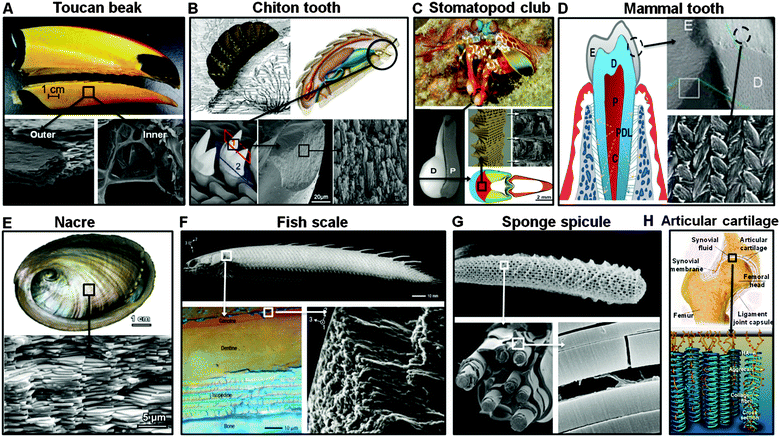Abrasion-resistant materials have attracted great attention for their broad applications in industry, biomedicine and military. However, the development of abrasion-resistant materials that have with unique features such as being lightweight and flexible remains a great challenge in order to satisfy unmet demands. The outstanding performance of natural abrasion-resistant materials motivates the development of new bio-inspired abrasion-resistant materials. This review summarizes the recent progress in the investigation of natural abrasion-resistant materials to explore their general design principles (i.e., the correlation between chemical components and structural features). Following natural design principles, several artificial abrasion-resistant materials have shown unique abrasion-resistant properties. The potential challenges in the future and possible solutions for designing bio-inspired abrasion-resistant materials are also briefly discussed. Chem. Soc. Rev., 2015 
Macroscale images and corresponding micro/nano structures of natural abrasion-resistant materials. (A) The toucan beak can be utilized for feeding purposes, and consists of an exterior shell based on overlapping keratin scales connected by glue. (B) The chiton radular tooth with a closely packed magnetite rod-like ultrastructure is used for grazing algae from rocky surfaces. (C) The stomatopod dactyl club has a chitin fiber-based twisted structure to reduce external impact when smashing the highly mineralized shells of prey. (D) Mammalian teeth are used for cutting and chewing food, and the enamel coating consists of woven rod-based structures composed of hydroxyapatite. (E) The layer-like nacre of the gastropod assembled by micrometer scaled aragonite platelets protects its inner soft body. (F) Fish scales can be used for preventing attack from their predators, and have rod-like, pseudo-prismatic crystallites of apatite in their ganoine layer. (G) The glass sponge supports its entire structure from fracture, exhibiting a fiber-reinforced composite structure with silica spicule bundles embedded in a layered silica matrix. (H) Articular cartilage can be used for locomotion, where the mechanically trapped complex of hyaluronic acid and lubricin can be used for the reduction of friction and the elimination of wear damage to the rubbing/shearing surfaces. (A) Adapted from ref. 4 Copyright 2005, Elsevier Ltd. (B) Adapted from ref. 5 Copyright 2010, Elsevier Ltd. (C) Adapted from ref. 6 Copyright 2012, Science. (D) Adapted from ref. 7 Copyright 2008, Cambridge University Press. (E) Adapted from ref. 8 Copyright 2011, Elsevier B.V. (F) Adapted from ref. 9 Copyright 2008, Nature Publishing Group. (G) Adapted from ref. 10 Copyright 2005, The American Association for the Advancement of Science. (H) Adapted from ref. 11 Copyright 2011, The National Academy of Sciences of the USA. |

